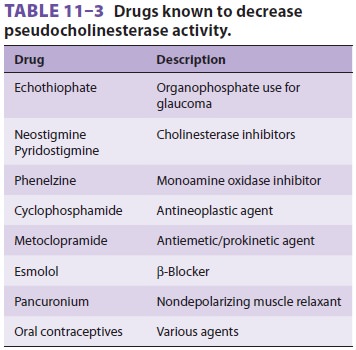Chapter: Clinical Anesthesiology: Clinical Pharmacology: Local Anesthetics
Local Anesthetic: Drug Interactions
Drug Interactions
Local anesthetics potentiate
nondepolarizing mus-cle relaxant blockade in laboratory experiments, but the
clinical importance of this observation is unknown (and probably nil).
Succinylcholine and ester local
anesthetics depend on pseudocholinesterase for metabolism. Concurrent
administration might conceivably increase the time that both drugs remain
unmetabo-lized in the bloodstream. There is likely no actual clinical
importance of this potential interaction.
Dibucaine, an amide local anesthetic,
inhib-its pseudocholinesterase, and the extent of inhibi-tion by dibucaine
defines one family of genetically abnormal pseudocholinesterases .
Pseudocholinesterase inhibitors (eg, organophos-phate poisons) can prolong the
metabolism of ester local anesthetics (see Table 11–3).

Histamine (H2) receptor blockers and β block-ers (eg, propranolol) decrease
hepatic blood flow and lidocaine clearance. Opioids potentiate epidural and
spinal analgesia produced by local anesthet-ics. Similarly α2-adrenergic agonists (eg, clonidine)
potentiate local anesthetic analgesia produced after epidural or peripheral nerve
block injections. Epidural chloroprocaine may interfere with the analgesic
actions of neuraxial morphine, notably after cesarean delivery.
Related Topics